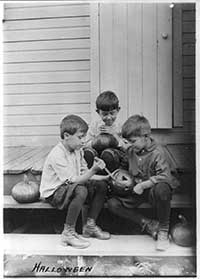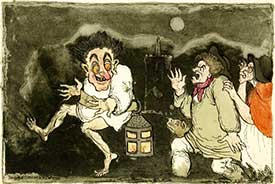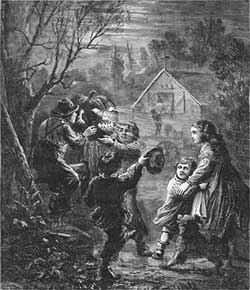Why Are Pumpkins Part of Halloween?

Shorter days and nippy nights herald the onset of autumn. For kids across America that means time to find the perfect pumpkin for this year’s Jack-O-Lantern. But who is Jack and what do carved pumpkins have to do with Halloween?
The Jack in Jack-O-Lantern. Our tale begins with legends about a guy named “Stingy Jack.” Jack had a reputation for manipulation and deceit, always looking to avoid work and make a buck at someone else’s expense. Word of his misdeeds made it all the way to Hades and Satan himself.
Curious to see if such a scoundrel really existed, the Master of the Underworld set out to find Jack, who was drunk when they met. Thinking his end had come, Jack asked Satan if he could enjoy one more drink before departing and they went to a local bar together.
Over beers, Jack cooked up a scheme with Satan to cheat the bar owner so their drinks would be free. Satan would turn into a coin that Jack would use for payment. Later Satan would resume his normal form and go home. Satan thought it would be great fun and agreed.
Satan turned into the coin at the end of the evening. But rather than give it to the bartender, Jack put the “coin” into his pocket alongside a silver cross.

The cross kept Satan from resuming his normal form. Jack’s price for releasing Satan was that Satan leave him alone for ten years. When Satan returned ten years later, Jack trapped him again with a different ruse. This time Jack’s price was higher: Satan would never take his soul.
But as they say, be careful what you ask for. When Jack died, he was denied entry to heaven, and Satan wouldn’t let him into Hades. After all, Satan reminded him, that was exactly what Jack himself had demanded. So Jack had to return to the surface, where it was dark. Jack complained he couldn’t find his way, so Satan tossed him an ember from the flames of Hell. Jack placed it into a hollowed turnip, whcih he used as a lantern.
Jack has wandered the Earth with his turnip lamp ever since. Nighttime travelers seeing spooky, strange lights in the distance, sometimes think they have spotted Jack.
What Does Stingy Jack Have to Do with Pumpkins? Absolutely nothing, except for contributing the name Jack to Jack-O-Lantern.

People in Ireland and Scotland traditionally put lanterns with scary faces outside their homes to keep evil spirits away, especially during the festival of Samhain, which is observed at the end of harvest season on October 31 and November 1. Spirits and faries were thought to be unusually active at that time. The lanterns were carved from gourds, turnips and beets.
Early American settlers brought their stories and traditions with them, including those regarding scary autumn lanterns. Here they found pumpkins, a North American variety of squash, were perfect for carving lanterns.
In America, however, the lanterns were more typically created to scare young children than evil spirits, as is seen in the 1867 illustration from Harper’s Weekly. Incidentally, the Harper's article laments that the “rising” generation was abandoning this “quaint” custom. Seems even 150 years ago “old” folks thought young people were a rebellious lot.
* * * * *
Stingy Jack is still wandering. Maybe he’ll come to your door as a trick-or-treater this Halloween.
-----
- Photographer Unknown, Library of Congress (1917).
- Richard Newton, A Will o’ th’ Wisp; or Jack o’ Lantern!, 1795. British Museum.
- L.W. Atwater, The Pumpkin Effigy, Harper’s Weekly, November 23, 1867, p. 737, available on Google Books.
This article originally appeared in our free semi-monthly newsletter. To receive future issues, please add your name to the subscription list.

